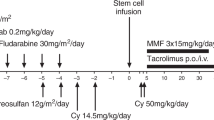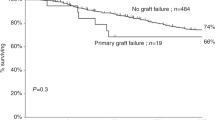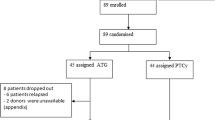Abstract
Primary graft failure after allogeneic hematopoietic cell transplantation is a life-threatening complication. A shortened conditioning regimen may reduce the risk of infection and increase the chance of survival. Here, we report the outcome of 11 patients with hematologic diseases (median age, 44; range, 25–67 years, seven males) who received a 1-day reduced-intensity preparative regimen given as a re-transplantation for primary graft failure. The salvage regimen consisted of fludarabine, cyclophosphamide, alemtuzumab and TBI, all administered 1 day before re-transplantation. All patients received T-cell replete PBSCs from the same or a different haploidentical donor (n=10) or from the same matched sibling donor (n=1). Neutrophil counts promptly increased to >500/μL for 10 of the 11 patients at a median of 13 days. Of these, none developed grade III/IV acute GVHD. At present, 8 of the 11 patients are alive with a median follow-up of 11.2 months from re-transplantation and 5 of the 8 are in remission. In conclusion, this series suggests that our 1-day preparative regimen is feasible, leads to successful engraftment in a high proportion of patients, and is appropriate for patients requiring immediate re-transplantation after primary graft failure following reduced-intensity transplantation.
This is a preview of subscription content, access via your institution
Access options
Subscribe to this journal
Receive 12 print issues and online access
$259.00 per year
only $21.58 per issue
Buy this article
- Purchase on Springer Link
- Instant access to full article PDF
Prices may be subject to local taxes which are calculated during checkout

Similar content being viewed by others
References
Storb R, Prentice RL, Thomas ED . Marrow transplantation for treatment of aplastic anemia. An analysis of factors associated with graft rejection. N Engl J Med 1977; 296: 61–66.
Aversa F, Terenzi A, Tabilio A, Falzetti F, Carotti A, Ballanti S et al. Full haplotype-mismatched hematopoietic stem-cell transplantation: a phase II study in patients with acute leukemia at high risk of relapse. J Clin Oncol 2005; 23: 3447–3454.
Koh LP, Rizzieri DA, Chao NJ . Allogeneic hematopoietic stem cell transplant using mismatched/haploidentical donors. Biol Blood Marrow Transplant 2007; 13: 1249–1267.
Kanda J, Chao NJ, Rizzieri DA . Haploidentical transplantation for leukemia. Curr Oncol Rep 2010; 12: 292–301.
Laughlin MJ, Eapen M, Rubinstein P, Wagner JE, Zhang MJ, Champlin RE et al. Outcomes after transplantation of cord blood or bone marrow from unrelated donors in adults with leukemia. N Engl J Med 2004; 351: 2265–2275.
Rocha V, Labopin M, Sanz G, Arcese W, Schwerdtfeger R, Bosi A et al. Transplants of umbilical-cord blood or bone marrow from unrelated donors in adults with acute leukemia. N Engl J Med 2004; 351: 2276–2285.
Atsuta Y, Suzuki R, Nagamura-Inoue T, Taniguchi S, Takahashi S, Kai S et al. Disease-specific analyses of unrelated cord blood transplantation compared with unrelated bone marrow transplantation in adult patients with acute leukemia. Blood 2009; 113: 1631–1638.
Steffens HP, Podlech J, Kurz S, Angele P, Dreis D, Reddehase MJ . Cytomegalovirus inhibits the engraftment of donor bone marrow cells by downregulation of hemopoietin gene expression in recipient stroma. J Virol 1998; 72: 5006–5015.
Carrigan DR, Knox KK . Human herpesvirus 6 (HHV-6) isolation from bone marrow: HHV-6-associated bone marrow suppression in bone marrow transplant patients. Blood 1994; 84: 3307–3310.
Johnston RE, Geretti AM, Prentice HG, Clark AD, Wheeler AC, Potter M et al. HHV-6-related secondary graft failure following allogeneic bone marrow transplantation. Br J Haematol 1999; 105: 1041–1043.
Scott BL, Sandmaier BM, Storer B, Maris MB, Sorror ML, Maloney DG et al. Myeloablative vs nonmyeloablative allogeneic transplantation for patients with myelodysplastic syndrome or acute myelogenous leukemia with multilineage dysplasia: a retrospective analysis. Leukemia 2006; 20: 128–135.
Le Blanc K, Remberger M, Uzunel M, Mattsson J, Barkholt L, Ringden O . A comparison of nonmyeloablative and reduced-intensity conditioning for allogeneic stem-cell transplantation. Transplantation 2004; 78: 1014–1020.
Spellman S, Bray R, Rosen-Bronson S, Haagenson M, Klein J, Flesch S et al. The detection of donor-directed, HLA-specific alloantibodies in recipients of unrelated hematopoietic cell transplantation is predictive of graft failure. Blood 2010; 115: 2704–2708.
Ciurea SO, de Lima M, Cano P, Korbling M, Giralt S, Shpall EJ et al. High risk of graft failure in patients with anti-HLA antibodies undergoing haploidentical stem-cell transplantation. Transplantation 2009; 88: 1019–1024.
Takanashi M, Atsuta Y, Fujiwara K, Kodo H, Kai S, Sato H et al. The impact of anti-HLA antibodies on unrelated cord blood transplantations. Blood 2010; 116: 2839–2846.
Kanda J, Rizzieri DA, Gasparetto C, Long GD, Chute JP, Sullivan KM et al. Adult dual umbilical cord blood transplantation using myeloablative total body irradiation (1350 cGy) and fludarabine conditioning. Biol Blood Marrow Transplant 2011; 17: 867–874.
Przepiorka D, Weisdorf D, Martin P, Klingemann HG, Beatty P, Hows J et al. 1994 Consensus conference on acute GVHD grading. Bone Marrow Transplant 1995; 15: 825–828.
Sullivan KM, Agura E, Anasetti C, Appelbaum F, Badger C, Bearman S et al. Chronic graft-versus-host disease and other late complications of bone marrow transplantation. Semin Hematol 1991; 28: 250–259.
Goggins TF, Rizzieri DA, Prosnitz R, Gasparetto C, Long G, Horwitz M et al. One day preparative regimen for allogeneic non-myeloablative stem cell transplantation (NMSCT) using 3–5/6 HLA matched related donors. Blood 2003; 102: 476b–477b (abstract 5633).
Rizzieri DA, Koh LP, Long GD, Gasparetto C, Sullivan KM, Horwitz M et al. Partially matched, nonmyeloablative allogeneic transplantation: clinical outcomes and immune reconstitution. J Clin Oncol 2007; 25: 690–697.
Byrne BJ, Horwitz M, Long GD, Gasparetto C, Sullivan KM, Chute J et al. Outcomes of a second non-myeloablative allogeneic stem cell transplantation following graft rejection. Bone Marrow Transplant 2008; 41: 39–43.
Sumi M, Shimizu I, Sato K, Ueki T, Akahane D, Ueno M et al. Graft failure in cord blood transplantation successfully treated with short-term reduced-intensity conditioning regimen and second allogeneic transplantation. Int J Hematol 2010; 92: 744–750.
Sauter C, Abboud M, Jia X, Heller G, Gonzales AM, Lubin M et al. Serious infection risk and immune recovery after double-unit cord blood transplantation without antithymocyte globulin. Biol Blood Marrow Transplant 2011 (e-pub ahead of print 1 March 2011; doi:10.1016/j.bbmt.2011.02.001).
Ogawa H, Ikegame K, Yoshihara S, Kawakami M, Fujioka T, Masuda T et al. Unmanipulated HLA 2-3 antigen-mismatched (haploidentical) stem cell transplantation using nonmyeloablative conditioning. Biol Blood Marrow Transplant 2006; 12: 1073–1084.
Ahmed N, Leung KS, Rosenblatt H, Bollard CM, Gottschalk S, Myers GD et al. Successful treatment of stem cell graft failure in pediatric patients using a submyeloablative regimen of campath-1H and fludarabine. Biol Blood Marrow Transplant 2008; 14: 1298–1304.
Tanaka T, Matsubara H, Adachi S, Chang H, Fujino H, Higashi Y et al. Second transplantation from HLA 2-loci-mismatched mother for graft failure due to hemophagocytic syndrome after cord blood transplantation. Int J Hematol 2004; 80: 467–469.
Dvorak CC, Gilman AL, Horn B, Cowan MJ . Primary graft failure after umbilical cord blood transplant rescued by parental haplocompatible stem cell transplantation. J Pediatr Hematol Oncol 2009; 31: 300–303.
Yoshihara S, Ikegame K, Taniguchi K, Kaida K, Kim EH, Nakata J et al. Salvage haploidentical transplantation for graft failure using reduced-intensity conditioning. Bone Marrow Transplant 2011 (e-pub ahead of print 11 April 2011; doi:10.1038/bmt.2011.84).
Morris EC, Rebello P, Thomson KJ, Peggs KS, Kyriakou C, Goldstone AH et al. Pharmacokinetics of alemtuzumab used for in vivo and in vitro T-cell depletion in allogeneic transplantations: relevance for early adoptive immunotherapy and infectious complications. Blood 2003; 102: 404–406.
Cobbold M, Khan N, Pourgheysari B, Tauro S, McDonald D, Osman H et al. Adoptive transfer of cytomegalovirus-specific CTL to stem cell transplant patients after selection by HLA-peptide tetramers. J Exp Med 2005; 202: 379–386.
Peggs KS, Verfuerth S, Pizzey A, Khan N, Guiver M, Moss PA et al. Adoptive cellular therapy for early cytomegalovirus infection after allogeneic stem-cell transplantation with virus-specific T-cell lines. Lancet 2003; 362: 1375–1377.
Orti G, Lowdell M, Fielding A, Samuel E, Pang K, Kottaridis P et al. Phase I study of high-stringency CD8 depletion of donor leukocyte infusions after allogeneic hematopoietic stem cell transplantation. Transplantation 2009; 88: 1312–1318.
Amrolia PJ, Muccioli-Casadei G, Huls H, Adams S, Durett A, Gee A et al. Adoptive immunotherapy with allodepleted donor T-cells improves immune reconstitution after haploidentical stem cell transplantation. Blood 2006; 108: 1797–1808.
Roy DC, Lachance S, Kiss T, Cohen S, Busque L, Fish D et al. Haploidentical stem cell transplantation: high doses of alloreactie-T cell depleted donor lymphocytes administered post-transplant decrease infections and improve survival without causing severe GVHD. Blood (ASH Annual Meeting Abstracts) 2009; 114: 512.
Waki F, Masuoka K, Fukuda T, Kanda Y, Nakamae M, Yakushijin K et al. Feasibility of reduced-intensity cord blood transplantation as salvage therapy for graft failure: results of a nationwide survey of adult patients. Biol Blood Marrow Transplant 2011; 17: 841–851.
Acknowledgements
The study investigators wish to thank the nurse practitioners, physician’s assistants, ward and clinic nurses, and staff of the Duke Adult Stem Cell Transplant Program for their outstanding care of the patients described in this report. JK is a Research Fellow of the Japan Society for the Promotion of Science. This work is supported in part by a Scholar in Clinical Research award from the Leukemia and Lymphoma Society (DAR), and NIH Grant P01-CA047741 (NJC).
Author information
Authors and Affiliations
Corresponding author
Ethics declarations
Competing interests
The authors declare no conflict of interest.
Rights and permissions
About this article
Cite this article
Kanda, J., Horwitz, M., Long, G. et al. Outcomes of a 1-day nonmyeloablative salvage regimen for patients with primary graft failure after allogeneic hematopoietic cell transplantation. Bone Marrow Transplant 47, 700–705 (2012). https://doi.org/10.1038/bmt.2011.158
Received:
Revised:
Accepted:
Published:
Issue Date:
DOI: https://doi.org/10.1038/bmt.2011.158
Keywords
This article is cited by
-
Revisiting a single day salvage conditioning following graft failure
Bone Marrow Transplantation (2022)
-
Non-relapse cytopenias following allogeneic stem cell transplantation, a case based review
Bone Marrow Transplantation (2022)
-
Successful rescue transplant for children with primary graft failure using early intervention with a single day preparative regimen and related haploidentical donor
Bone Marrow Transplantation (2021)
-
Feasibility of salvage cord blood transplantation using a fludarabine, melphalan, and low-dose anti-thymocyte globulin conditioning regimen
International Journal of Hematology (2019)
-
Non-myeloablative conditioning for second hematopoietic cell transplantation for graft failure in patients with non-malignant disorders: a prospective study and review of the literature
Bone Marrow Transplantation (2017)



